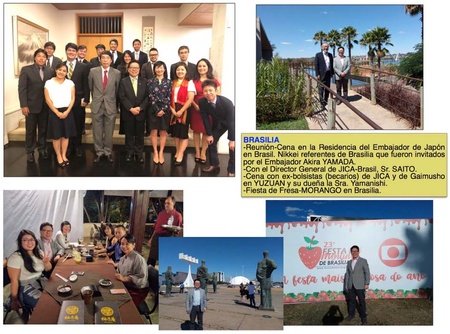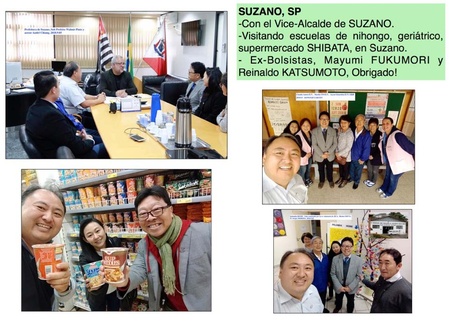At the end of August 2018, I had the opportunity to attend an international symposium called "Conference of Collaborators: Contemporary Japan - Integration of Brazilians in Japan into Japanese Society" held in São Paulo, Brazil, at the invitation of the Ministry of Health, Labor and Welfare. I also took the opportunity to visit local Japanese communities.
The "Collaboradores Conference" is a meeting organized annually by CIATE 1 (Center for Information and Assistance for Brazilian Overseas Workers), which was established by the Japanese government in the 1990s to support Brazilian workers of Japanese descent. Thirty years have passed since Brazilians and Peruvians began coming to Japan for work, and currently there are 190,000 Brazilians and 48,000 Peruvians residing in Japan, most of whom have already settled there. However, in some cases, their integration into Japanese society is less smooth than that of Japanese descendants from other countries, and educational issues such as children not attending school and low high school enrollment rates have been pointed out. For this reason, this symposium was held with the awareness of the problem that the social integration of Brazilians living in densely populated areas throughout Japan is insufficient.
The meeting was attended by prominent experts, high-ranking officials from the Brazilian Ministry of Foreign Affairs, former workers, and from Japan, Kazuo Tabata, Deputy Director-General for Employment Security at the Ministry of Health, Labor and Welfare. On the afternoon of the second day, the 26th, I gave a speech on the theme of "The Relationship between Japanese-descendants in Japan and Japanese Society," and presented the following using graphs and images.
- Foreigners with any type of residence status can increase their chances of development, mitigate risks, and strengthen their defenses by deepening their ties with Japanese society. However, if they create closed communities for themselves or continue to suffer from feelings of inferiority, they will not be able to make the most of these opportunities.
- Increasing competition in the labor market has led to a rush to integrate into society. In fact, the number of foreign students, technical interns, and workers with specific skills has exceeded 600,000, and is expected to increase by another 300,000 in the next few years.
- Asian workers tend to stay in Japan for a long time and make realistic life plans without much hesitation because wages in their home countries are lower than in South America. In addition, we should make efforts to increase their contributions through social integration and to be recognized as human resources with potential.
- The introduction of AI (artificial intelligence) and other technologies is bringing about major changes in Japanese factories and general workplaces, as well as changes in the manufacturing, service, and commercial structures. In this environment, foreigners need to promote themselves in order to have their diversity and different cultures appreciated. Furthermore, by overcoming misunderstandings and prejudices about differences and becoming good neighbors and local residents, new possibilities will emerge.
During their stay in Sao Paulo, the group visited the modern Santa Cruz Hospital, which is run mainly by Japanese doctors and businesspeople, and Colonia Pinhal 2 , also known as "Fukui Village," located 170 kilometers southwest of the city by car. They also spent a meaningful time visiting their former students working at Japan House in the city and friends at the Japan Foundation. They were also given the opportunity to meet with members of the Association of Former Visitors to Japan by the Ministry of Foreign Affairs, where they were able to exchange frank opinions across generations.

Afterwards, I flew to the capital, Brasilia, and not only met with the former trainees, but also, with the help of Ambassador Yamada of Japan to Brazil, had the opportunity to meet with influential Nikkei people involved in the central government, politics, media, etc. at the Ambassador's residence. Here, too, I was given the opportunity to provide an overview of the report of the Ministry of Foreign Affairs' Latin America and Caribbean Affairs Bureau's Expert Panel on Nikkei people (the report was submitted to the government in May 20173). As an aside, Ambassador Yamada has listened to my opinions on several occasions, and since his time as Director-General of the Latin America and Caribbean Affairs Bureau, he has emphasized the need to extend Japanese assistance to Nikkei people as a target of cooperation.
The group was also guided by Clarice Aoto, a Japanese-Brazilian adviser to members of the Brazilian Congress who visited Japan in 2018 at the invitation of the Ministry of Foreign Affairs, who gave them a tour of the Congress and related organizations, and also showed them a Japanese-Brazilian farming community on the outskirts of Brasilia and a facility where a strawberry festival is held.
Currently, it is said that 7,000 to 8,000 Japanese people live in the capital Brasilia and its surrounding areas, but when the capital was relocated in 1960, Japanese people who had settled in the southern state of Paraná were encouraged to relocate to Brasilia for agricultural development. At that time, second and third generation doctors, architects, and engineers in various fields were also relocated, and some Japanese people remained in the new capital even after their contracts ended. It seems that most Japanese people now live in satellite cities on the outskirts of Brasilia rather than in the city itself. However, there are Japanese language schools, Japanese associations, and very delicious Japanese restaurants in the city. I was also able to meet Karina Yamanishi, a Japanese university student who came to Japan last year on a JICA exchange program, and we were able to chat with other Japanese people while enjoying a variety of delicious dishes at "Yuzuan 4 ", run by her mother.

After three days of stay, I went to Porto Velho (meaning Old Port) in Rondonia state5 in western Brazil , close to Bolivia. It is a city in the subtropical region facing the upper reaches of the Madeira River, a tributary of the Amazon River, about three hours by plane from the capital Brasilia. In 1954, 29 Japanese families came here to cultivate rubber trees as part of the postwar settlement of Amazonia. They cleared the virgin forest and cultivated the fields so that various crops could be cultivated. They also expanded their business by raising chickens, pigs, pepper, orchards, and livestock, contributing to the prosperity of the region. Gradually, some people moved to other cities and settlements, so now only a few Japanese families live here.
The current president of the Japanese Association is Mariela Tamada, a second-generation Japanese Argentine who is married to a doctor of third-generation Japanese Brazilian descent. I met her when I was in Japan as a JICA trainee. I had always wanted to visit Porto Velho, and this time I was finally able to make it happen. Although there are few Japanese people, there are many non-Japanese people who are interested in Japanese manga and anime, so there is a Japanese language school. When I visited, the Japanese Association was holding a Bon Odori dance, so I also attended. One of the JICA Youth Cooperation Volunteers for Japanese Communities was also dispatched, and I was able to get a glimpse of a very interesting small-scale Japanese community.

Afterwards, I visited Suzano, a city on the outskirts of São Paulo with a population of 15,000 Japanese descendants. There are several municipalities in the surrounding area, and each area has tens of thousands of Japanese descendants living there. I was surprised to find an excellent Japanese Association called "Bunkyou Suzano," several Japanese language schools, a large general facility called Aceas Nikkey, and even a highly equipped nursing home called Iperlandia Home. I visited almost all of the facilities in the Japanese community in one day, and found it to be a fairly large community6 .
Mayor Rodrigo Asiuchi is a third-generation Japanese, and there are several Japanese in the city government executive ranks. Among them, Reinaldo Katsumata, director of the health and sanitation bureau and inaugurated as chairman of the Suzano Bunkyo Association at this year's executive meeting, is the most active Japanese leader. He also participated in the "Japanese Cultural Activities Coordinator Training" program as a JICA trainee in 2018.
Suzano is a commercial and industrial city where many Japanese people live and where many Japanese companies have set up operations. Early Japanese immigrants to Suzano were Nakamura Zenzaburo and others who arrived on the Kasato Maru in 1908 and relocated to the area a few years later, and their stories are engraved on their gravestones in the city's cemetery. There are many marble graves and ossuaries, which tell the story of many of the Japanese who were quite wealthy and successful.

The communities of Porto Velho and Suzano that I visited this time were very contrasting and interesting, so I will write about them in more detail on another occasion.
This business trip to Brazil started in Sao Paulo and ended in Brasilia, Porto Velho, Campinas, and Suzano, and I was reminded of the vastness of this country. The Japanese community is also very diverse, and their subsequent development differs depending on the circumstances of their settlement or relocation, and each has developed its own unique community. The oriental town of Liberdade in the city of Sao Paulo is often thought of as the representative of the Japanese community in Brazil, but today there is an overwhelming presence of Chinese merchants rather than Japanese people, and it is impossible to understand the Japanese community in Brazil just by visiting this place.
I was honored to have been able to attend the Collabradores Conference, and my visit to Brazil made me realize that I want to continue to understand the diversity and potential of this incredible country.
Notes:
1. CIATE (Centre for Information and Assistance for Overseas Workers): Sao Paulo, Brazil. The current chairman is Professor Masato Ninomiya of the University of Sao Paulo.
2. Located in the city of São Miguel Arcanjo in the state of São Paulo, this settlement was established in 1962 by JICA and Fukui Prefecture. There is also a Japanese model school , and the level of Japanese language education for children and the wadaiko group is said to be very high. In 2015, Enka singer Hiroshi Itsuki, who is from Fukui Prefecture, visited the settlement.
3. The book contains the contents of the meetings and final report of the Ministry of Foreign Affairs' " Expert Panel on Cooperation with Japanese Communities in Latin America ." At the third meeting, I emphasized that a different understanding is needed, such as the current changes in Japanese communities and the expectations of the next generation.
4. Alice Yamanishi, the owner and chef of " Yuzu-an ", previously came to Japan as a JICA trainee and received training in Japanese cuisine.
5. It was officially recognized as a state by the 1988 Constitution. Before that it was the Federal Territory of Guaporé.
6. The current president of the Suzano Bunkyo is Reinaldo Katsumata , who came to Japan two years ago as a JICA trainee. He is the city's health and hygiene director and is also active in the Japanese community. As an aside, the current mayor of Suzano is Rodrigo Asiuchi, who is of Japanese descent. In 2019, the mayor came to Japan at the invitation of the Ministry of Foreign Affairs as a leader of the next generation of Japanese descent.
© 2020 Alberto J. Matsumoto






